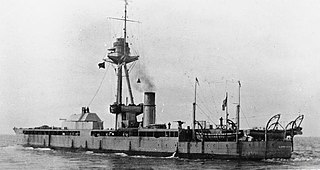
The M29 class comprised five monitors of the Royal Navy, all built and launched during 1915.

The first HMS Zulu was a Tribal class destroyer launched 16 September 1909 at Hawthorn Leslie Shipyard and commissioned in March 1910. She was mined during the First World War, on 27 October 1916 off Dover in a minefield lain by the Imperial German submarine UC-1. Her stern was blown off and sank, but the forward section remained afloat. It was towed into port and attached to the stern of Nubian, which had been torpedoed, to form a new destroyer named HMS Zubian.

The Erebus class of warships was a class of 20th century Royal Navy monitors armed with a main battery of two 15-inch /42 Mk 1 guns in a single turret. It consisted of two vessels, Erebus and Terror, named after the two ships lost in the Franklin Expedition. Both were launched in 1916 and saw active service in World War I off the Belgian coast. After being placed in reserve between the wars, they served in World War II, with Terror being lost in 1941 and Erebus surviving to be scrapped in 1946.

HMS Conquest was a C-class light cruiser of the Royal Navy that saw service during World War I. She was part of the Caroline group of the C class.

HMS Lord Clive was the lead ship of her class of eight monitors built for the Royal Navy during World War I. Their primary armament was taken from obsolete pre-dreadnought battleships. The ship spent the war in the English Channel bombarding German positions along the Belgian coast as part of the Dover Patrol, often serving as a flagship. She participated in the failed First Ostend Raid in 1918, bombarding the defending coastal artillery as the British attempted to block the Bruges–Ostend Canal. Lord Clive was one of two ships in the class fitted with a single 18-inch (457 mm) gun in 1918, but she only fired four rounds from it in combat before the end of the war in November. The ship conducted gunnery trials after the war and was sold for scrap in 1927.

HMS Marshal Soult was a Royal Navy Marshal Ney-class monitor constructed in the opening years of the First World War. Laid down as M14, she was named after the French general of the Napoleonic Wars Marshal Nicolas Jean de Dieu Soult. She served in both World Wars and was decommissioned in 1946.

HMS General Wolfe, also known as Wolfe, was a Lord Clive-class monitor which was built in 1915 for shore-bombardment duties in the First World War. Her class of eight ships was armed by four obsolete Majestic-class pre-dreadnoughts which had their 12-inch guns and mounts removed, modified and installed in the newly built monitors. Wolfe spent her entire war service with the Dover Patrol, bombarding the German-occupied Belgian coastline, which had been heavily fortified. In the spring of 1918 she was fitted with an 18-inch (457 mm) gun, with which she made the longest-range firing in the history of the Royal Navy - 36,000-yard (20 mi) - on a target at Snaeskerke, Belgium. After the war, she was laid up before being stripped and put up for sale in 1920. She was finally scrapped in 1923.

HMS M29 was a Royal Navy M29-class monitor of the First World War. The ship was constructed by Harland & Wolff, in Belfast and launched on 22 May 1915, she was completed in June 1915. During World War I, the monitor served in the Mediterranean Sea at the Battle of Jaffa in 1917 and took part in operations in support of British and White Russian forces in the White Sea during the Russian Civil War in 1919. The ship was then converted to a minelayer and renamed HMS Medusa in 1925. In 1941 Medusa was converted to a repair and depot ship and was renamed HMS Talbot, then renamed HMS Medway II in 1944. In 1946, the vessel was sold for scrap.

HMS M31 was an M29-class monitor of the Royal Navy.

The M15 class comprised fourteen monitors of the Royal Navy, all built and launched during 1915.
HMS M27 was a First World War Royal Navy M15-class monitor. She was also served in the British intervention in Russia in 1919, and was scuttled in the Dvina River on 16 September 1919.
HMS M25 was a First World War Royal Navy M15-class monitor. She was also served in the British intervention in Russia in 1919, and was scuttled in the Dvina River on 16 September 1919.
HMS M26 was a First World War Royal Navy M15-class monitor.
HMS M20 was a First World War Royal Navy M15-class monitor.
HMS M19 was a First World War Royal Navy M15-class monitor.
HMS M22 was a First World War Royal Navy M15-class monitor. Later converted to a minelayer and renamed HMS Medea, she was wrecked whilst being towed for breaking up on 2 January 1939.
HMS M23 was a First World War Royal Navy M15-class monitor. After service in the Mediterranean and the Dover Patrol, she was also served in the British intervention in Russia in 1919. Converted to the RNVR drillship Claverhouse in 1922, she served in that capacity at "Leith" until 1958.
HMS M24 was a First World War Royal Navy M15-class monitor. After service in the Dover Patrol, she was also served in the British intervention in Russia in 1919. She was sold in mercantile service in 1920.

HMS M17 was a First World War Royal Navy M15-class monitor.
HMS M16 was a First World War Royal Navy M15-class monitor.











